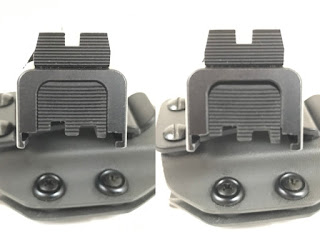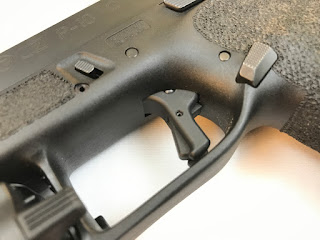The trigger on my black P-10 started failing to fire lately even after I swapped back in the factory trigger. I could pull the trigger fully to the rear and the striker wouldn't release. This only occurred occasionally during dry-fire, never with live ammo. It's not the trigger but a combination of the trigger bar and the striker sleeve. Compared to my FDE trigger bar, the "hook" that catches the striker leg sticks up about 1/8" higher when fully back. Normally, it's still low enough to release the striker except when the slide and slide plate are pushed down. The striker liner is flexible enough to allow the whole assembly to squeeze slightly out of the slide's striker channel. The resulting lowering of the striker leg, means the trigger bar can't move down far enough to cleanly release it. If I push the cover plate up, it raises the striker enough to release from the trigger bar. I swapped, strikers, trigger bars, connectors, and the rear housings around, but the only thing that made a difference was the trigger bar. Examining the two, the lug on the FDE is cut lower, resulting in a higher "hook".
With striker fired guns, I've always noticed more consistent trigger pulls with a mag full of dummy rounds. The rounds provide more magazine spring pressure to force the slide to its highest position on the rails, while with no dummy ammo/mag, the slide is pretty much free to rest at any height. The P-10C has a pretty sloppy slide to rail fit for reliability (normal for striker fired guns) and the cover plate has some movement which exacerbates the inconsistency. When fitting Ghost connectors with over-travel tabs for my Glocks, I always push the slide down while dry firing to ensure the trigger bar will always release the striker.
The biggest issue is the striker housing. Since its plastic and open at the rear, the slot can get squeezed if you press the slide cover down, and the spring pressure can hold it there. I think it's the reason for one FTRTBs I had when the plate dropped enough to hang on the rear of the trigger housing, preventing the last 1/8" of slide travel. Some newer P-10C have a bevel on the slide plate to let it ride back up if it gets too low. Fortunately, when in battery, the slide plate does limit the amount the striker assembly can drop down. Short of sending my P-10C back to CZ (I've modified mine enough that I probably voided the warranty) I think the immediate solution is to bevel the bottom front edges of the slide cover plate, and shave 0.010" off the trigger bar on the mill. I have a feeling I'll be overhauling some of my parts once spares become available.
***Update***
I sanded a bevel onto the retaining plate to match the ramp on the center leg. The plate will now be forced up as the slide goes into battery instead of catching. I also shaved 0.0255" off the ledge on the trigger bar. I setup the mill to cut the trigger bar at a three degree angle. I wanted the cut to stop short of the striker safety lug. I wanted to unsure that the striker didn't hit the "hump" as it travels forward. Then I cleaned up the edges with an X-fine ceramic stone.
The striker releases 100% now. Originally the trigger had about 2mm of movement after the wall and zero over-travel. Now it has about 1mm of movement during the break and 1mm of over-travel. The break honestly feels like a 1911, just with more take-up. Not a high-end 1911. Grab the cheapest new 1911 you can find at a gun store. That's how the trigger feels. My only concern is milling into a MIM part. Unlike barstock, MIM parts are usually only surface hardened. However, since I didn't cut into the face of the ledge, the exposed metal only contacts the striker leg as the slide recoils backward. It's held upward by slight pressure from the trigger springs, so impact should be minimal. I'll monitor it as I shoot it more.





















































